Influence of the Sphericity Coefficient on the Deposition Characteristics of Aerosol Particles on the Surface of Photovoltaic (PV) Modules: Numerical Simulation
Abstract
1. Introduction
2. Model and Process
2.1. Motion Equation
2.2. Physical Model and Mesh Division
2.3. Grid Independence Verification
2.4. Process
2.4.1. Boundary Conditions
2.4.2. Simulation Process
- (1)
- Development of the simulation calculation of the velocity field and pressure field distribution around the photovoltaic (PV) module;
- (2)
- According to Table 2, perform 21 simulation calculations (combination of different d and different ψ) of aerosol particle sedimentation dynamics to analyze the variation of aerosol particle n (aerosol particles mass deposited on the per unit area surface of the photovoltaic (PV) module, kg/m2) with Ψ under different particle size conditions;
- (3)
- Analyze the influence mechanism of the Ψ on the deposition process of aerosol particles in the photovoltaic (PV) field combined with the distribution characteristics of the flow field around the photovoltaic (PV) module;
- (4)
- Disclose the influence law and mechanism of the Ψ for the distribution characteristics of aerosol particles on the surface of the photovoltaic (PV) module d = 20 μm.
2.5. Trial Control
2.5.1. Test Bench and Wind Tunnel
2.5.2. Particle Sample Acquisition
2.5.3. Instrumentation
2.5.4. Aerosol Particle Deposition Test
3. Results and Discussions
3.1. Analysis of Numerical Simulation
3.1.1. Flow Field Characteristics
- (1)
- The gas micro-mass flowing into the calculation domain would first reach the surface of the near-ground photovoltaic (PV) module and collide with it, then lose part of the kinetic energy to rapidly reduce the flow rate and cause retention;
- (2)
- With the extension of time, more and more gas micro-clusters would be retained on the surface of the near-ground side photovoltaic (PV) module, increasing the pressure of this region;
- (3)
- When the retention amount of gas micro-clusters reaches the threshold, the mainstream would be squeezed out and then be far away from the surface of the near-ground side photovoltaic (PV) module, and finally approximately tangentially across the surface of the far-ground side photovoltaic (PV) module;
- (4)
- When air micro-clusters pass through the far-ground side surface of the photovoltaic (PV) module, the collision probability is greatly reduced, which makes the airflow velocity larger and the air pressure lower.
3.1.2. Influence of the Spherical Coefficient on the Distribution Characteristics of Aerosol Particles
3.1.3. Influence of the Spherical Coefficient on the Deposition Amount of Aerosol Particles
- (1)
- Combining Equations (5)–(8), it could be seen that the larger ψ was, the smaller the force between aerosol particles and the air was;
- (2)
- When the aerosol particles follow the gas flow, the larger the ψ was, the smaller the drag force of the airflow on the aerosol particles was, the longer the velocity response time was, and the greater the inertial force of the aerosol particles was;
- (3)
- When the airflow by-passes the surface of the photovoltaic (PV) module, the airflow direction and velocity would all be changed greatly. At this time, the larger the ψ was, the easier it was for the aerosol particles to break away from the constraints of the airflow and then deposit on the surface of the photovoltaic (PV) module;
- (4)
- The specific surface area of aerosol particles decreases with the increase of d, which leads to the decrease in the ratio of drag force to inertia force;
- (5)
- When d = 10 μm, the drag force would play a leading role for a single aerosol particle. At this time, the aerosol particles had a good follow-up to the airflow, resulting in relatively more aerosol particles by-passing the surface of the photovoltaic (PV) module, so n was relatively small;
- (6)
- When d gradually increased to 20 μm, the inertial force would play a dominant role for a single aerosol particle. At this time, the ability of aerosol particles to break away from the airflow was also enhanced, which led to a relative increase in n;
- (7)
- When d continues to increase to 30 μm, gravity would play a dominant role for a single aerosol particle. At the same time, relatively more aerosol particles settled to the ground before reaching the surface of the photovoltaic (PV) module, and only relatively few aerosol particles had deposited on the surface of the photovoltaic (PV) module.
- (1)
- A deviation exists between the flow field inside the wind tunnel and the simulated flow field. The flow field from the dynamic section to the contraction section exhibits non-uniformity, with the latter section having a larger diameter, leading to a lower wind speed compared to the set value of 3.5 m/s in the closed section. Consequently, a discrepancy occurs between the particle deposition characteristics and the simulation, specifically within the dynamic and contraction sections;
- (2)
- To simplify the model and reduce computational complexity, the particle phase was directly defined as dilute in the simulation. The assumption was made that there is no collision or agglomeration of particles during their motion with the airflow. Additionally, in the simulation, the photovoltaic components were assigned a no-slip boundary condition, indicating that particles deposited on their surface do not experience secondary motion. However, in wind tunnel experiments, there is a possibility that a small number of particles may undergo secondary motion;
- (3)
- In the simulation, all particles were standardized to a size of 30 μm, assuming uniform particle size and sphericity factor. However, during the experiments, particles were selected using sieves, which may result in the inclusion of particles smaller than 30 μm.
4. Conclusions
- (1)
- Under the set boundary conditions, the airflow velocity near the surface of the photovoltaic component shows an increasing trend from bottom to top, with the lowest velocity on the near-ground side. The minimum value is 2.2 m/s, and the maximum value is 3.89 m/s. The air pressure near the surface of the photovoltaic component shows a decreasing trend from bottom to top, with the highest pressure on the near-ground side. The maximum value is 10 pa, and the minimum value ranges between 3.33–5.56 pa;
- (2)
- Irrespective of particle size, the accumulation of particles during settling is shown to increase as the sphericity factor increases;
- (3)
- After reaching the surface of the photovoltaic component, particles predominantly accumulate on the near-ground side. The maximum deposition amount of various spherical coefficients on the surface of the photovoltaic panel near the ground side is 1.5 kg/m2, with the minimum value ranging from 1.4~1.434 kg/m2. Nevertheless, with a gradual increase in the sphericity factor, the particle distribution becomes more dispersed and covers the entire surface.
Author Contributions
Funding
Institutional Review Board Statement
Informed Consent Statement
Data Availability Statement
Conflicts of Interest
References
- Worrell, E.; Bernstein, L.; Roy, J.; Price, L.; Harnisch, J. Industrial Energy Efficiency and Climate Change Mitigation. In Renewable Energy; Routledge: London, UK, 2018; pp. Vol1_548–Vol1_568. [Google Scholar]
- Bloch, H.; Rafiq, S.; Salim, R. Economic Growth with Coal, Oil and Renewable Energy Consumption in China: Prospects for Fuel Substitution. Econ. Model. 2015, 44, 104–115. [Google Scholar] [CrossRef]
- Vithayasrichareon, P.; Riesz, J.; MacGill, I.F. Using Renewables to Hedge against Future Electricity Industry Uncertainties—An Australian Case Study. Energy Policy 2015, 76, 43–56. [Google Scholar] [CrossRef]
- Klitkou, A.; Coenen, L. The emergence of the Norwegian solar photovoltaic industry in a regional perspective. Eur. Plan. Stud. 2013, 21, 1796–1819. [Google Scholar] [CrossRef]
- Chen, Y.; Liu, Y.; Tian, Z.; Dong, Y.; Zhou, Y.; Wang, X.; Wang, D. Experimental Study on the Effect of Dust Deposition on Photovoltaic Panels. Energy Procedia 2019, 158, 483–489. [Google Scholar] [CrossRef]
- Chen, J.; Pan, G.; Ouyang, J.; Ma, J.; Fu, L.; Zhang, L. Study on Impacts of Dust Accumulation and Rainfall on PV Power Reduction in East China. Energy 2020, 194, 116915. [Google Scholar] [CrossRef]
- Comerio, A.; Tassinari Scarpat, T.; Knaip Krause, R.C.; Fernandes, M.R.; Muniz, P.R. Performance of Photovoltaic Generators under Superficial Dust Deposition on their Modules Derived from Anthropogenic Activities. Acta Sci. Technol. 2020, 43, e50101. [Google Scholar] [CrossRef]
- Wu, Y.; Wang, H.; Li, S.; Li, R.; Wang, J. Dust Deposition Impact on Power Generation Performance of Photovoltaic Modules. Distrib. Energy 2017, 2, 55–59. [Google Scholar] [CrossRef]
- Kaldellis, J.K.; Fragos, P. Ash Deposition Impact on the Energy Performance of Photovoltaic Generators. J. Clean. Prod. 2011, 19, 311–317. [Google Scholar] [CrossRef]
- Salamah, T.; Ramahi, A.; Alamara, K.; Juaidi, A.; Abdallah, R.; Abdelkareem, M.A.; Amer, E.-C.; Olabi, A.G. Effect of Dust and Methods of Cleaning on the Performance of Solar PV Module for Different Climate Regions: Comprehensive Review. Sci. Total Environ. 2022, 827, 154050. [Google Scholar] [CrossRef]
- Mondal, A.K.; Bansal, K. A Brief History and Future Aspects in Automatic Cleaning Systems for Solar Photovoltaic Panels. Adv. Robot. 2015, 29, 515–524. [Google Scholar] [CrossRef]
- Liu, S.J.; Yue, Q.; Zhou, K.; Sun, K. Effects of Particle Concentration, Deposition and Accumulation on Photovoltaic Device Surface. Energy Procedia 2019, 158, 553–558. [Google Scholar] [CrossRef]
- Lu, H.; Lu, L.; Zhang, L.Z.; Pan, A. Numerical Study on Polydispersed Dust Pollution Process on Solar Photovoltaic Panels Mounted on a Building Roof. Energy Procedia 2019, 158, 879–884. [Google Scholar] [CrossRef]
- Abderrezek, M.; Fathi, M. Experimental study of the dust effect on photovoltaic panels’ energy yield. Sol. Energy 2017, 142, 308–320. [Google Scholar] [CrossRef]
- Bayrakci, M.; Choi, Y.; Brownson, J.R.S. Temperature Dependent Power Modeling of Photovoltaic. Energy Procedia 2014, 57, 745–754. [Google Scholar] [CrossRef]
- Skoplaki, E.P.; Palyvos, J.A. On the Temperature Dependence of Photovoltaic Module Electrical Performance: A Review of Efficiency/Power Correlations. Sol. Energy 2009, 83, 614–624. [Google Scholar] [CrossRef]
- Xu, X.; Wei, J.; Wang, M.; Jiang, W.; Wen, Z.; Liu, Y. Influence of inclination angle on dust migration and settlement characteristics of excavation roadway. Environ. Sci. Pollut. Res. 2022, 29, 83304–83320. [Google Scholar] [CrossRef]
- Roy, S. Impact of Carbon Dust Particle Deposition and Partial Shadow of PV Array. In Proceedings of the 2014 IEEE PES Asia-Pacific Power and Energy Engineering Conference (APPEEC), Hong Kong, China, 7–10 December 2014; pp. 1–5. [Google Scholar] [CrossRef]
- Appels, R.; Lefevre, B.; Herteleer, B.; Goverde, H.; Beerten, A.; Paesen, R.; De Medts, K.; Driesen, J.; Poortmans, J. Dusting Efficiency of Photovoltaic Modules: A Review and Improvement Using Controlled Experiments. Sol. Energy 2013, 96, 283–291. [Google Scholar] [CrossRef]
- Shi, J.; Zhang, W.; Guo, S.; An, H. Numerical Modelling of Blasting Dust Concentration and Particle Size Distribution during Tunnel Construction by Drilling and Blasting. Metals 2022, 12, 547. [Google Scholar] [CrossRef]
- Yilbas, B.S.; Ali, H.; Al-Sharafi, A.; Al-Aqeeli, N.; Abu-Dheir, N.; Al-Sulaiman, F.; Khaled, M. Dust Accumulation on Photovoltaic Panels: Influence of Environmental Dust Concentration and Panel Tilt Angle. Sol. Energy Mater. Sol. Cells 2017, 17, 186–194. [Google Scholar] [CrossRef]
- Alquthami, T.; Menoufi, K. Soiling of Photovoltaic Modules: Comparing between Two Distinct Locations within the Framework of Developing the Photovoltaic Soiling Index (PVSI). Sustainability 2019, 11, 4697. [Google Scholar] [CrossRef]
- Klugmann-Radziemska, E. Degradation of electrical performance of a crystalline photovoltaic module due to dust deposition in northern Poland. Renew. Energy 2015, 78, 418–426. [Google Scholar] [CrossRef]
- Bolio, E.J.; Sinclair, J.L. Gas turbulence modulation in the pneumatic conveying of massive particles in vertical tubes. Int. J. Multiph. Flow 1995, 21, 985–1001. [Google Scholar] [CrossRef]
- Heiss, J.F. The Effect of Orientation and Shape on the Settling Velocity of Non-Isometric Particles in a Viscous Medium. Chem. Eng. Prog. 1952, 48, 133–140. [Google Scholar]
- Qiu, Y.; Guo, X.; Wang, Y.; Tian, R.; Wei, C.; Liu, S. Deposition Characteristics of Aerosol Particles on the Surface of PV Modules: Numerical Study. Adv. Theory Simul. 2022, 6, 2200750. [Google Scholar] [CrossRef]
- Ferrada, P.; Olivares, D.; del Campo, V.; Marzo, A.; Araya, F.; Cabrera, E.; Llanos, J.; Correa-Puerta, J.; Portillo, C.; Román Silva, D.; et al. Physicochemical Characterization of Soiling from Photovoltaic Facilities in Arid Locations in the Atacama Desert. Sol. Energy 2019, 187, 47–56. [Google Scholar] [CrossRef]
- Yu, L.; Pan, Y.; Wu, Y. Research on Data Normalization Methods in Multi-Attribute Evaluation. In Proceedings of the 2009 International Conference on Computational Intelligence and Software Engineering, Wuhan, China, 11–13 December 2009; pp. 1–5. [Google Scholar] [CrossRef]
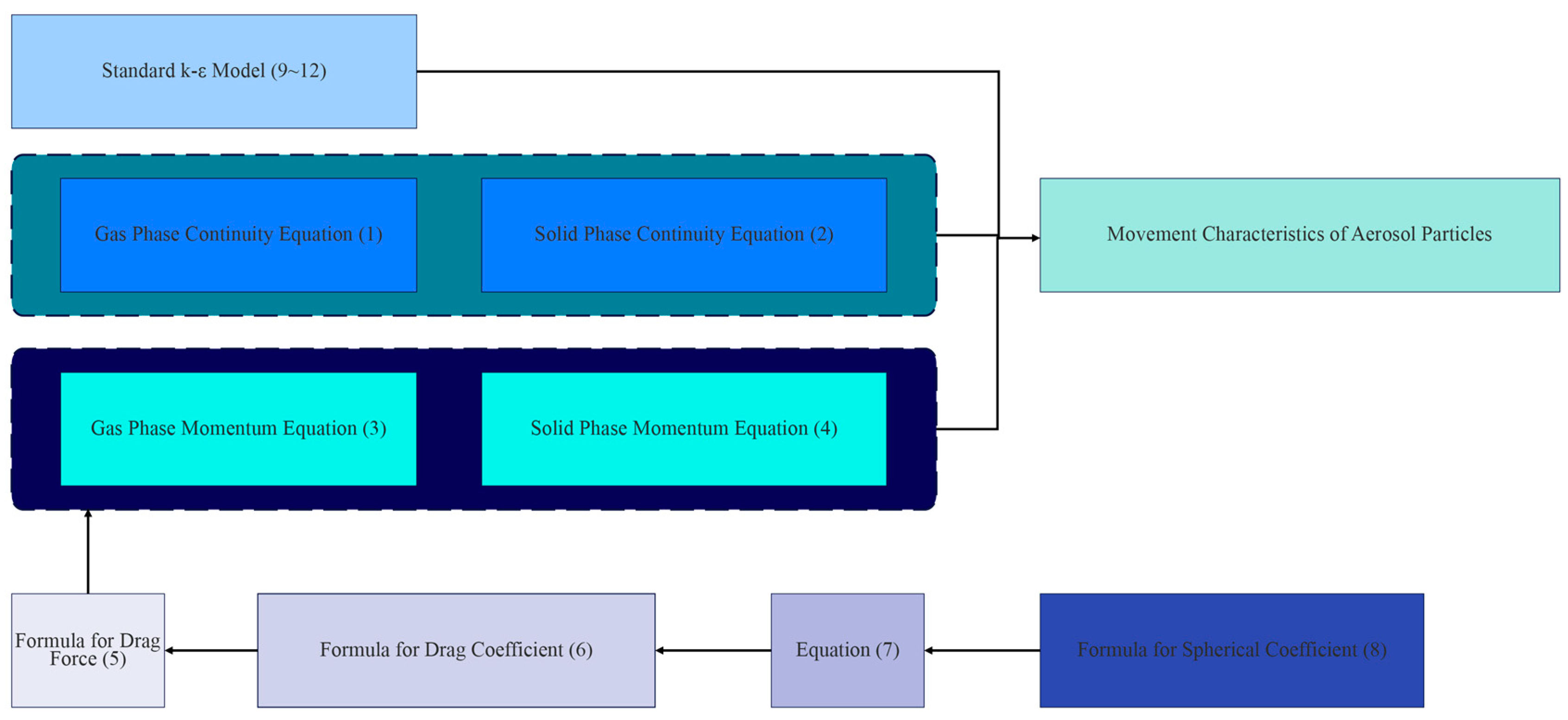
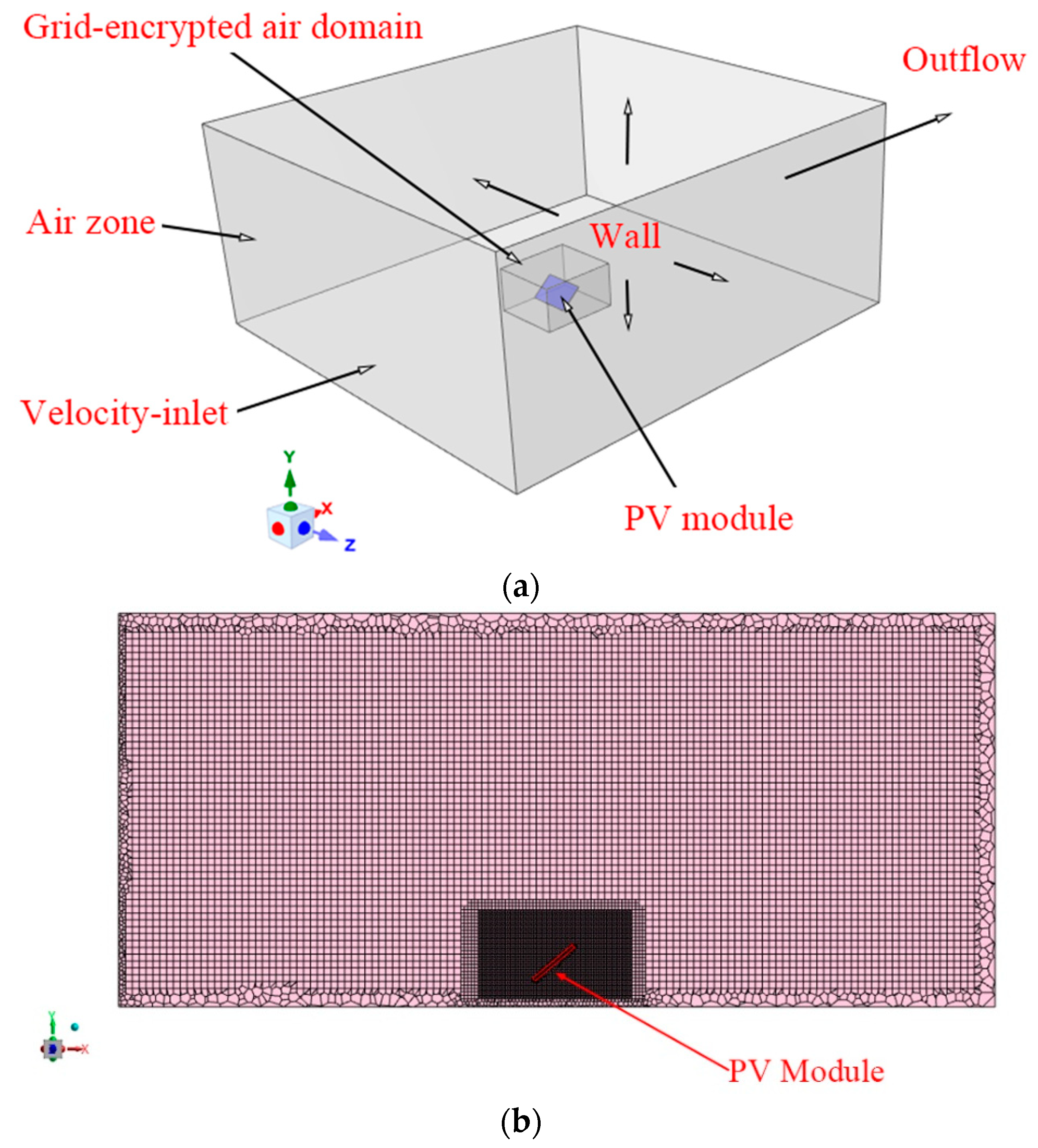

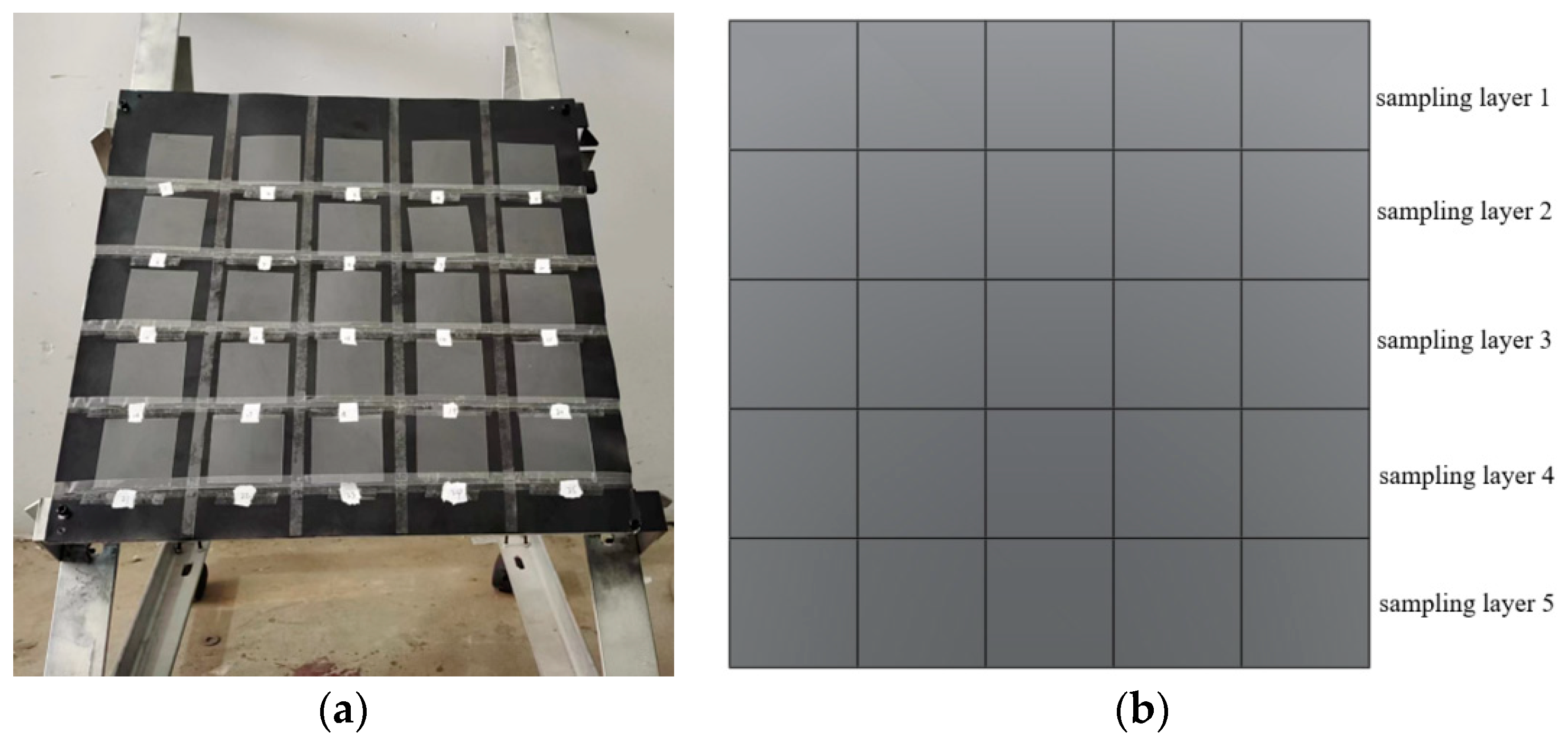
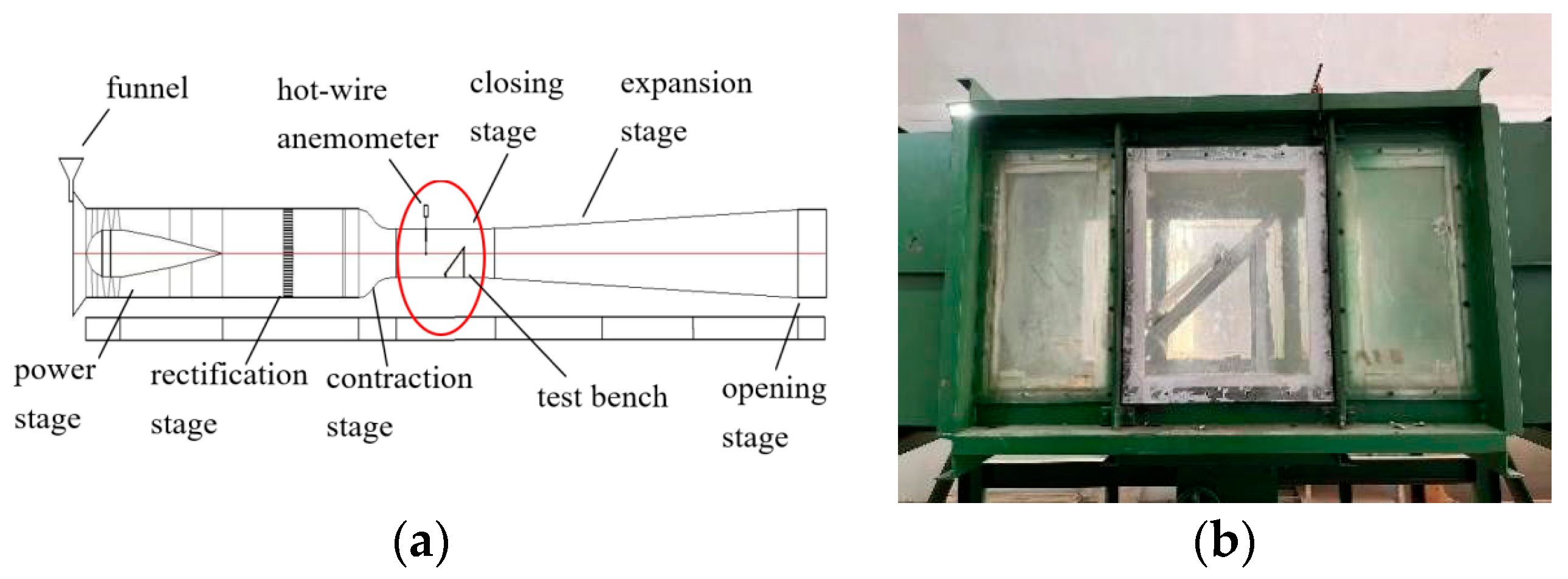
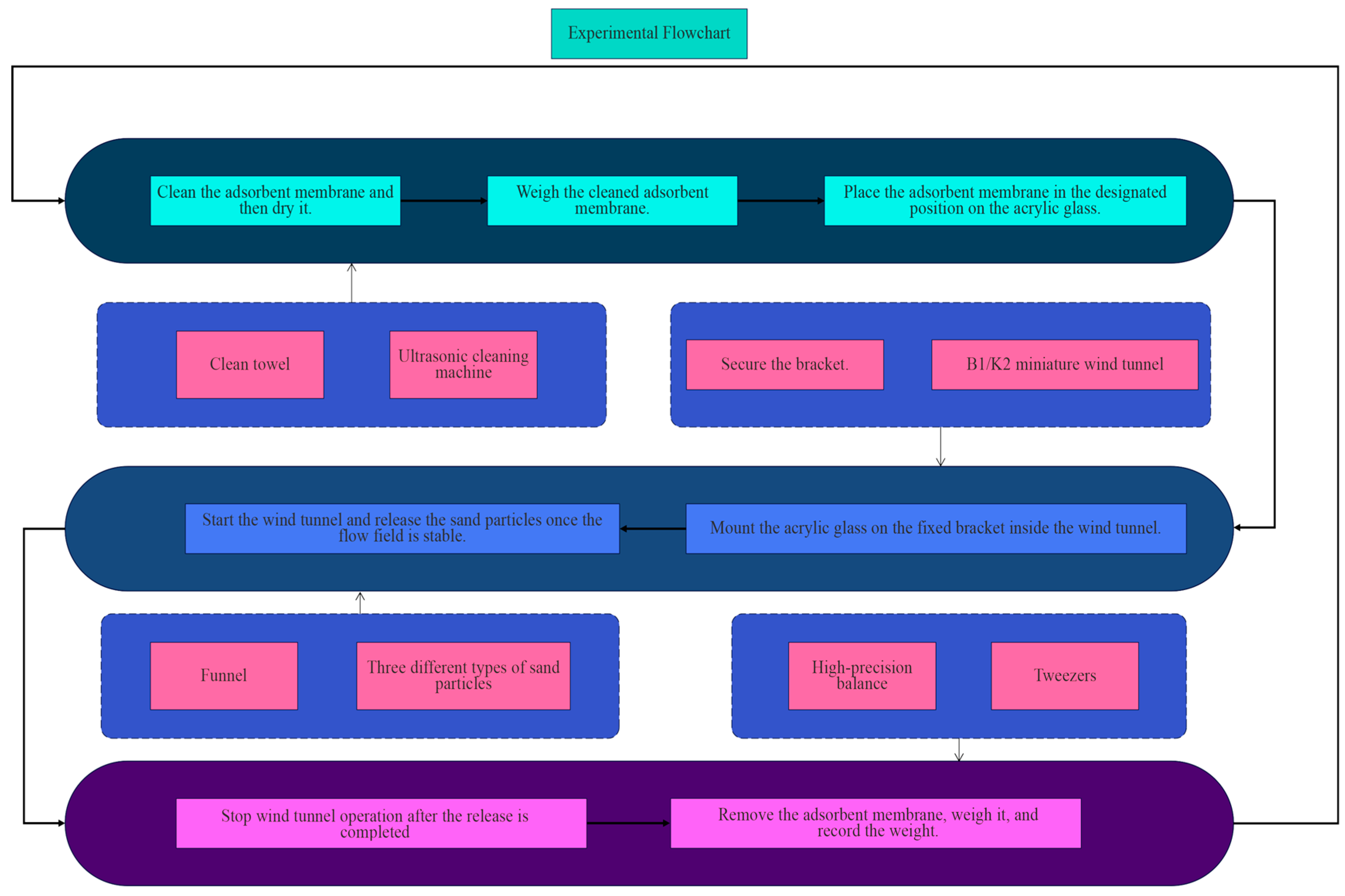
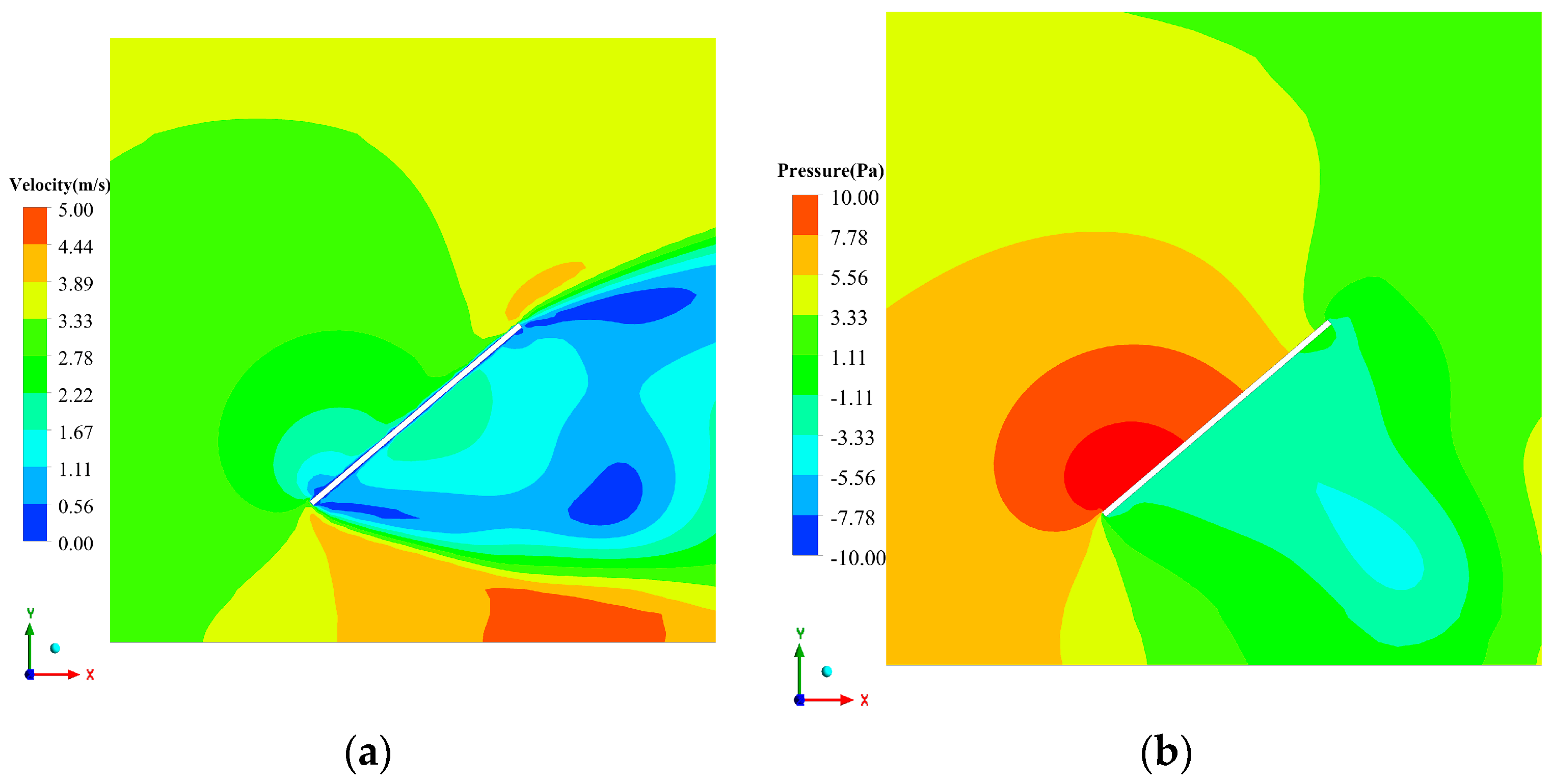
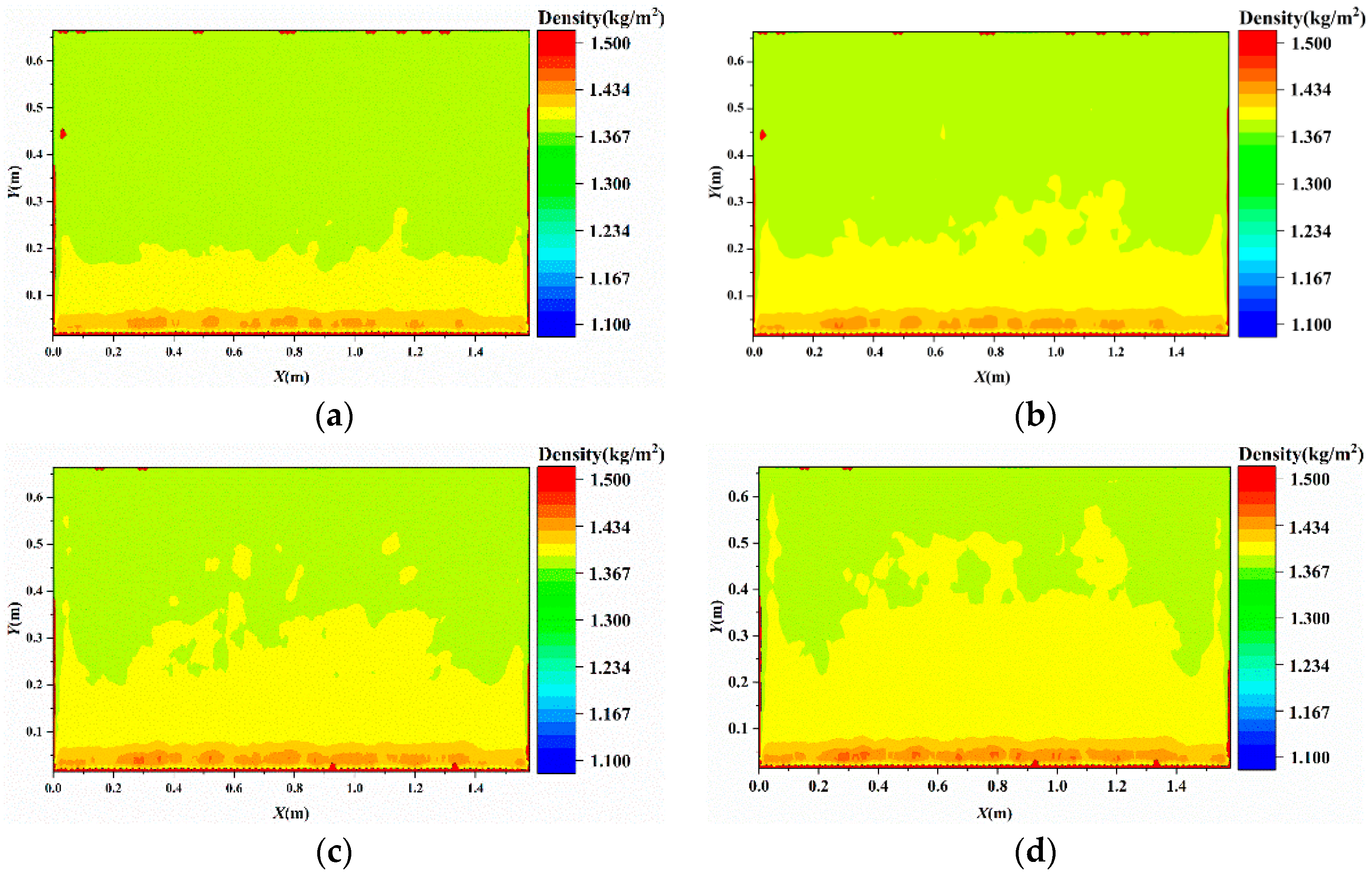
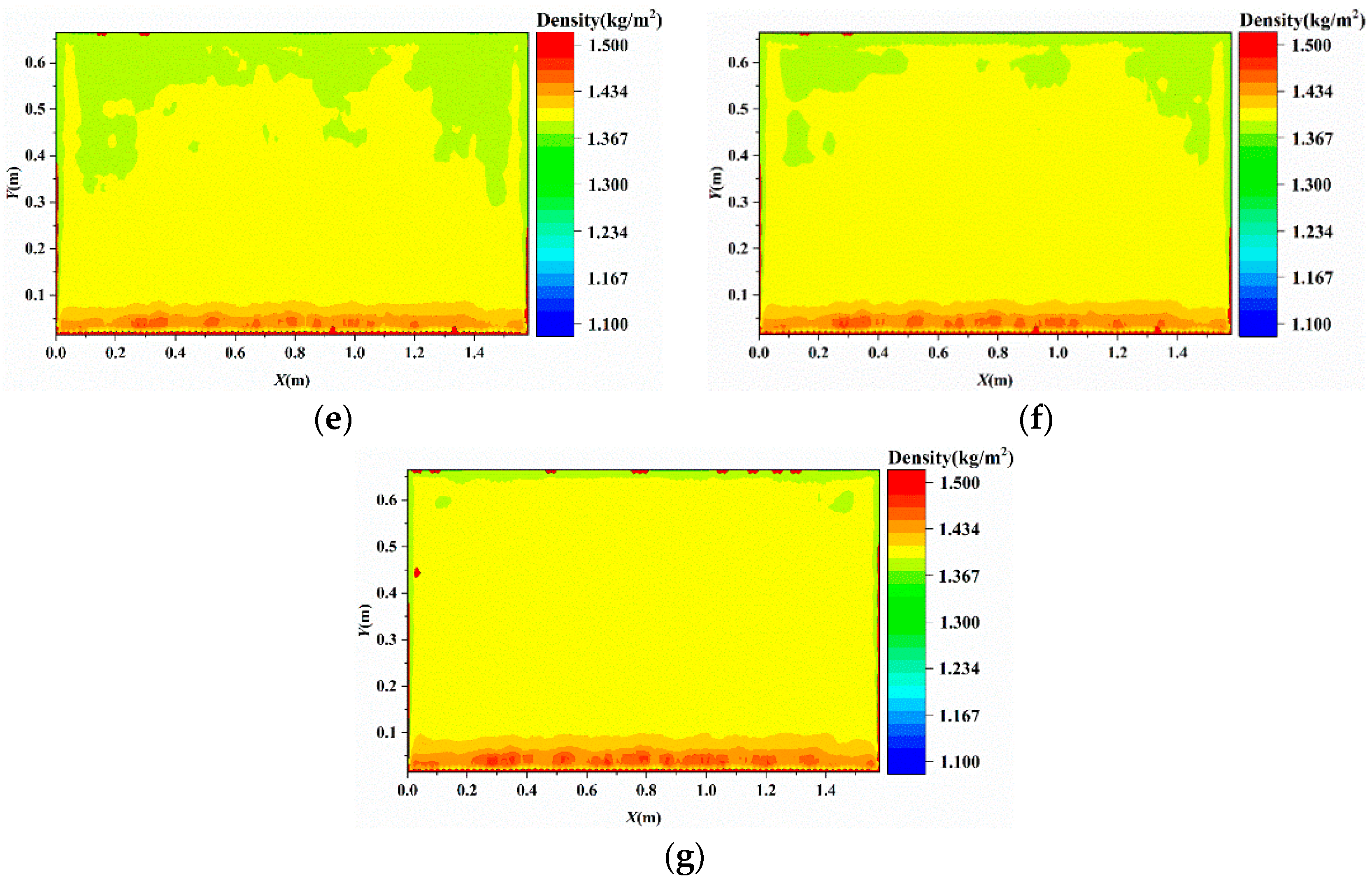
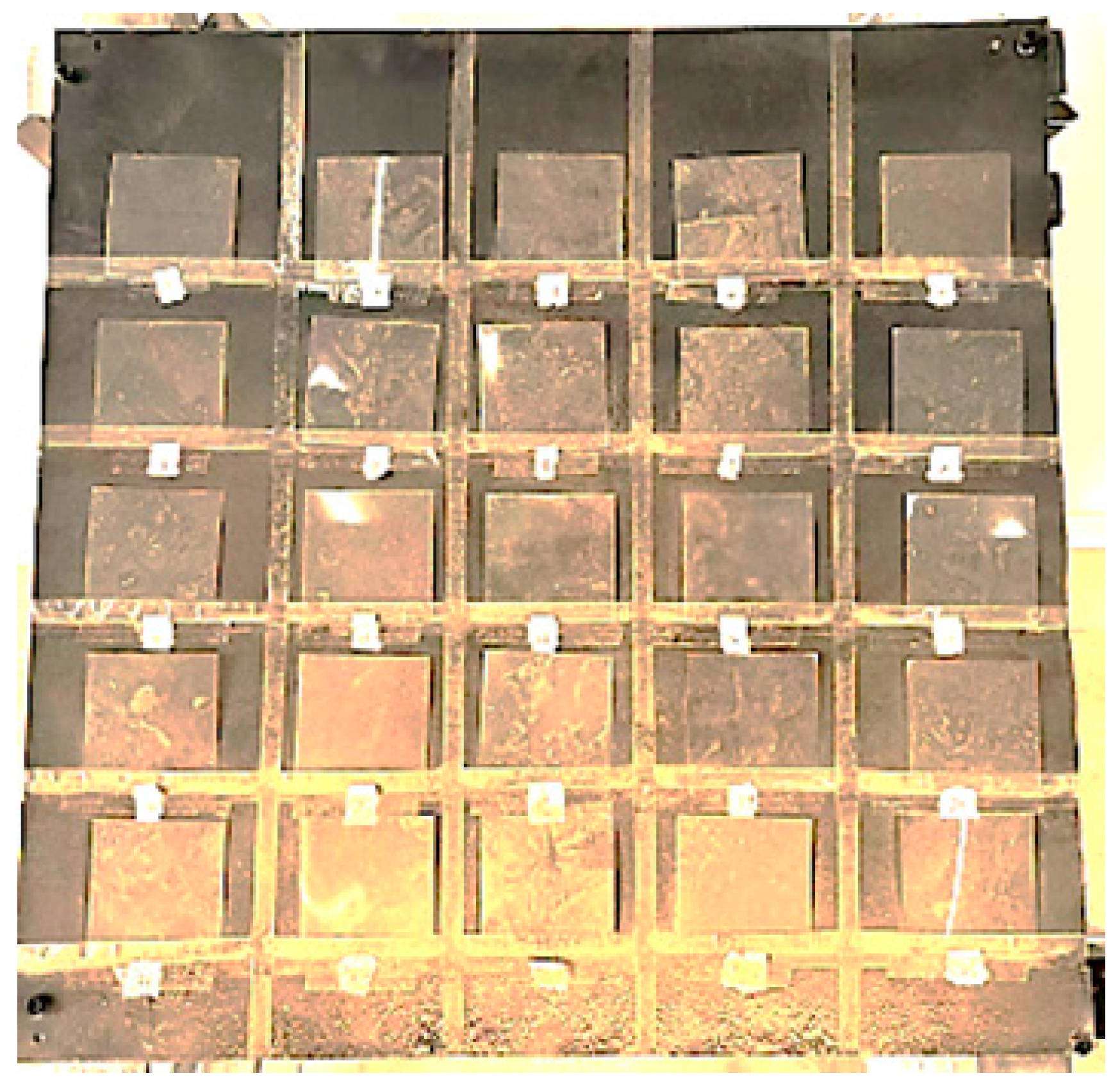



| Type | Value |
|---|---|
| Inflow wind speed | 3.50 m/s |
| Air density | 1.239 kg/m3 |
| Dynamic viscosity of air | 1.84 × 10−5 Pa·s |
| Aerosol particle density | 2650.00 kg/m3 |
| d | 10.00, 20.00, 30.00 μm |
| Ψ | 0.73~0.91 |
| Volume fraction of aerosol particle | 5.00 × 10−3% |
| Inlet boundary | Velocity-inlet |
| Outlet boundary | Outflow |
| Wall boundary | Non-slip wall |
| ψ | ||||||||
|---|---|---|---|---|---|---|---|---|
| 0.73 | 0.76 | 0.79 | 0.82 | 0.85 | 0.88 | 0.91 | ||
| d (μm) | 10.00 | Test-1 | Test-2 | Test-3 | Test-4 | Test-5 | Test-6 | Test-7 |
| 20.00 | Test-8 | Test-9 | Test-10 | Test-11 | Test-12 | Test-13 | Test-14 | |
| 30.00 | Test-15 | Test-16 | Test-17 | Test-18 | Test-19 | Test-20 | Test-21 | |
| Name | Model | Measurement Range | Precision |
|---|---|---|---|
| High-precision electronic balance | XPR504SIAC | 510 g | ±0.0001 g |
| Hot-line anemometer | 405i | 0~30 m/s | ±0.1 m/s |
Disclaimer/Publisher’s Note: The statements, opinions and data contained in all publications are solely those of the individual author(s) and contributor(s) and not of MDPI and/or the editor(s). MDPI and/or the editor(s) disclaim responsibility for any injury to people or property resulting from any ideas, methods, instructions or products referred to in the content. |
© 2023 by the authors. Licensee MDPI, Basel, Switzerland. This article is an open access article distributed under the terms and conditions of the Creative Commons Attribution (CC BY) license (https://creativecommons.org/licenses/by/4.0/).
Share and Cite
Wei, C.; Wang, Y.; Qiu, Y.; Guo, X. Influence of the Sphericity Coefficient on the Deposition Characteristics of Aerosol Particles on the Surface of Photovoltaic (PV) Modules: Numerical Simulation. Appl. Sci. 2023, 13, 8658. https://doi.org/10.3390/app13158658
Wei C, Wang Y, Qiu Y, Guo X. Influence of the Sphericity Coefficient on the Deposition Characteristics of Aerosol Particles on the Surface of Photovoltaic (PV) Modules: Numerical Simulation. Applied Sciences. 2023; 13(15):8658. https://doi.org/10.3390/app13158658
Chicago/Turabian StyleWei, Chuan, Yahui Wang, Yunfeng Qiu, and Xiao Guo. 2023. "Influence of the Sphericity Coefficient on the Deposition Characteristics of Aerosol Particles on the Surface of Photovoltaic (PV) Modules: Numerical Simulation" Applied Sciences 13, no. 15: 8658. https://doi.org/10.3390/app13158658
APA StyleWei, C., Wang, Y., Qiu, Y., & Guo, X. (2023). Influence of the Sphericity Coefficient on the Deposition Characteristics of Aerosol Particles on the Surface of Photovoltaic (PV) Modules: Numerical Simulation. Applied Sciences, 13(15), 8658. https://doi.org/10.3390/app13158658





